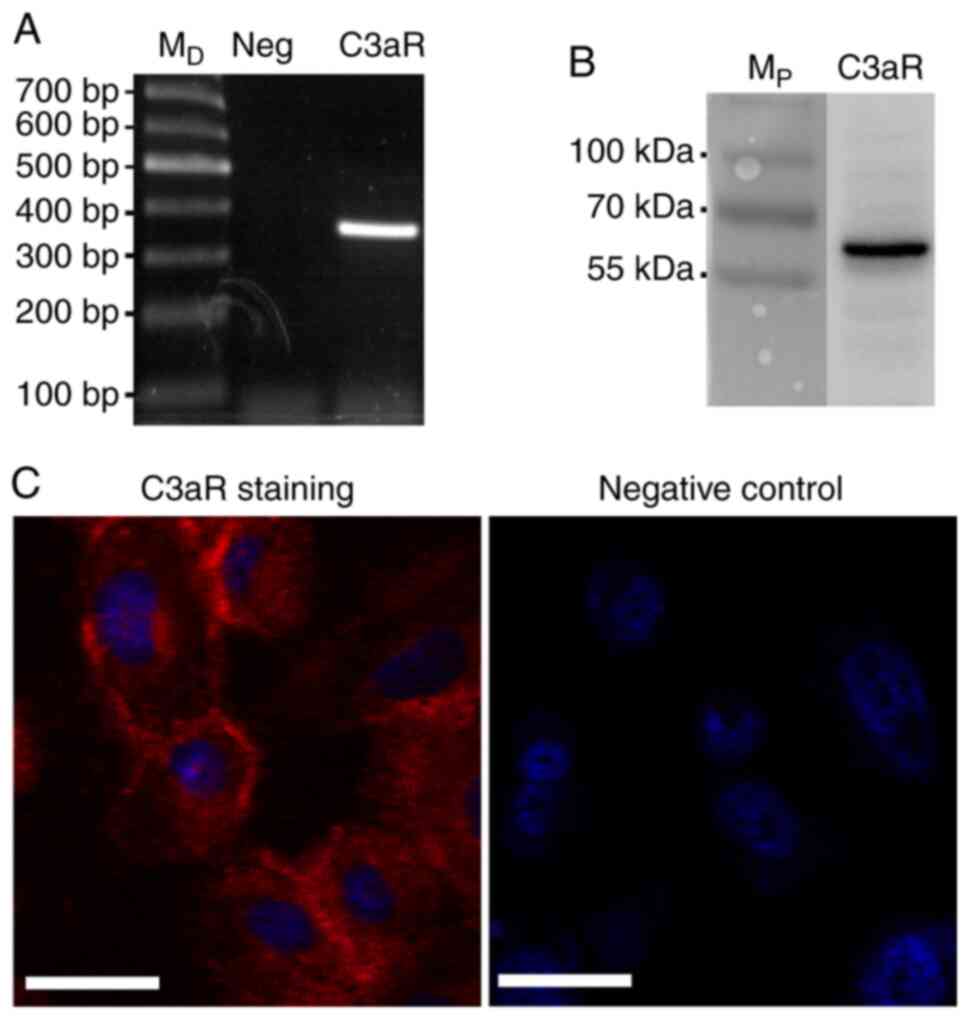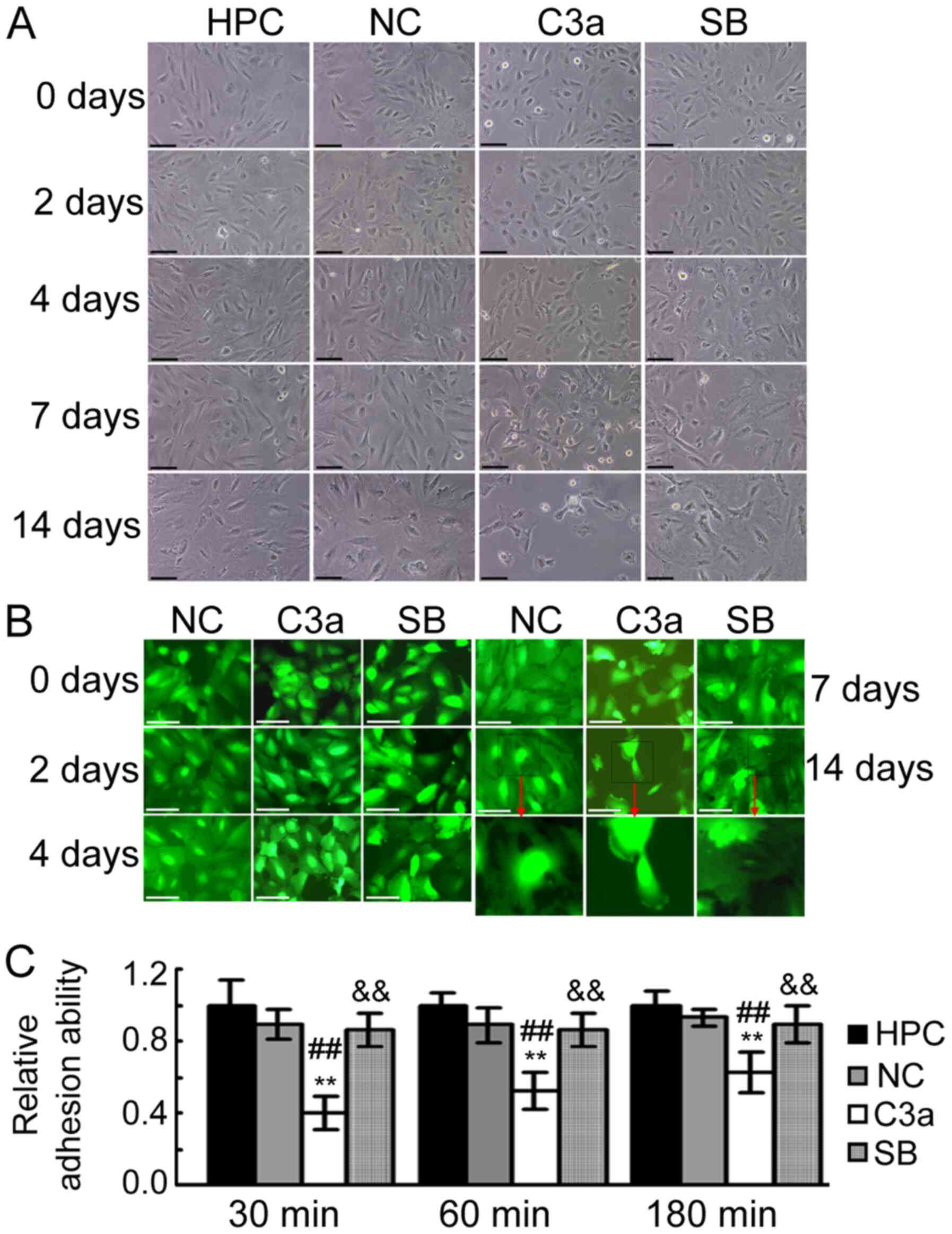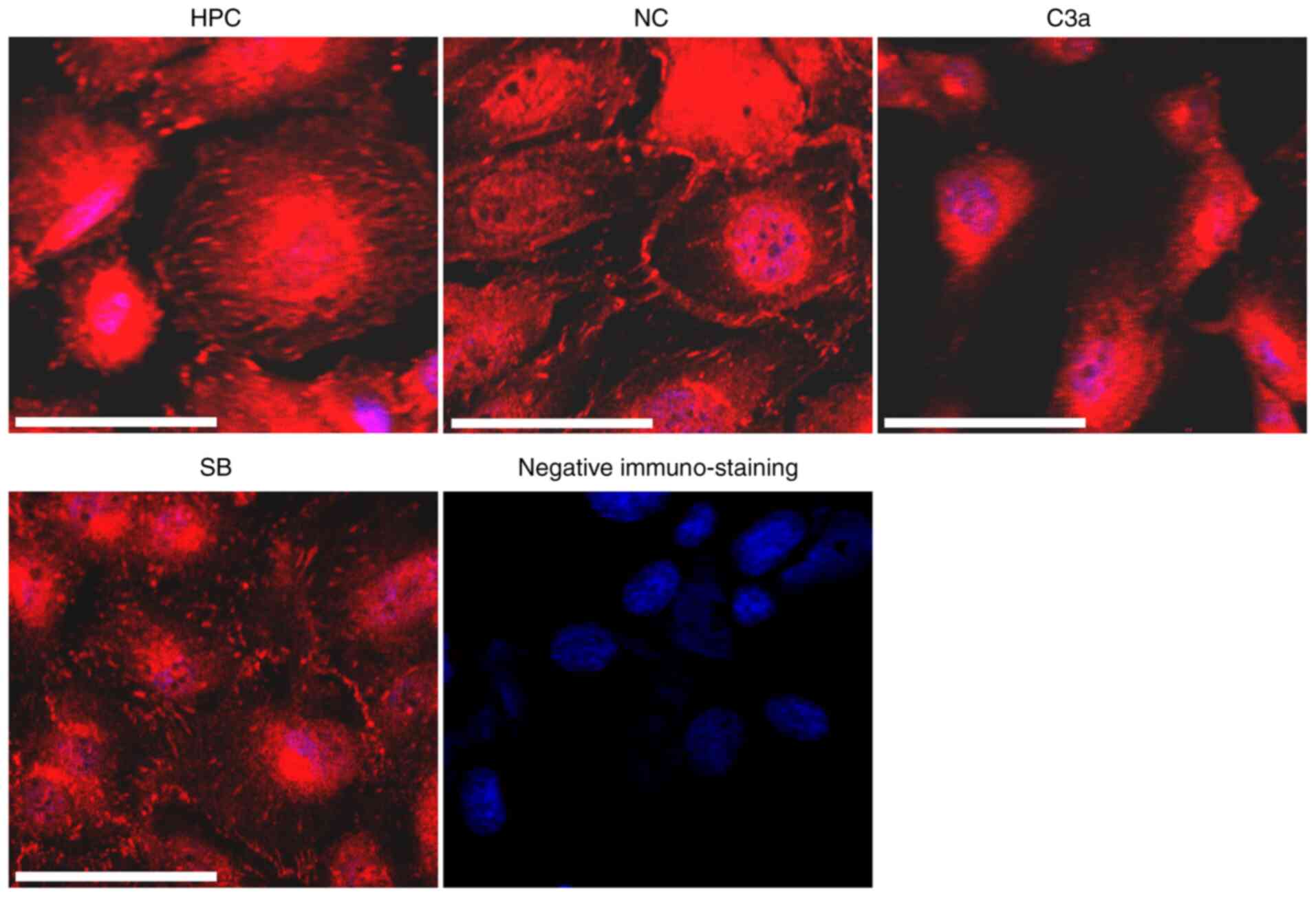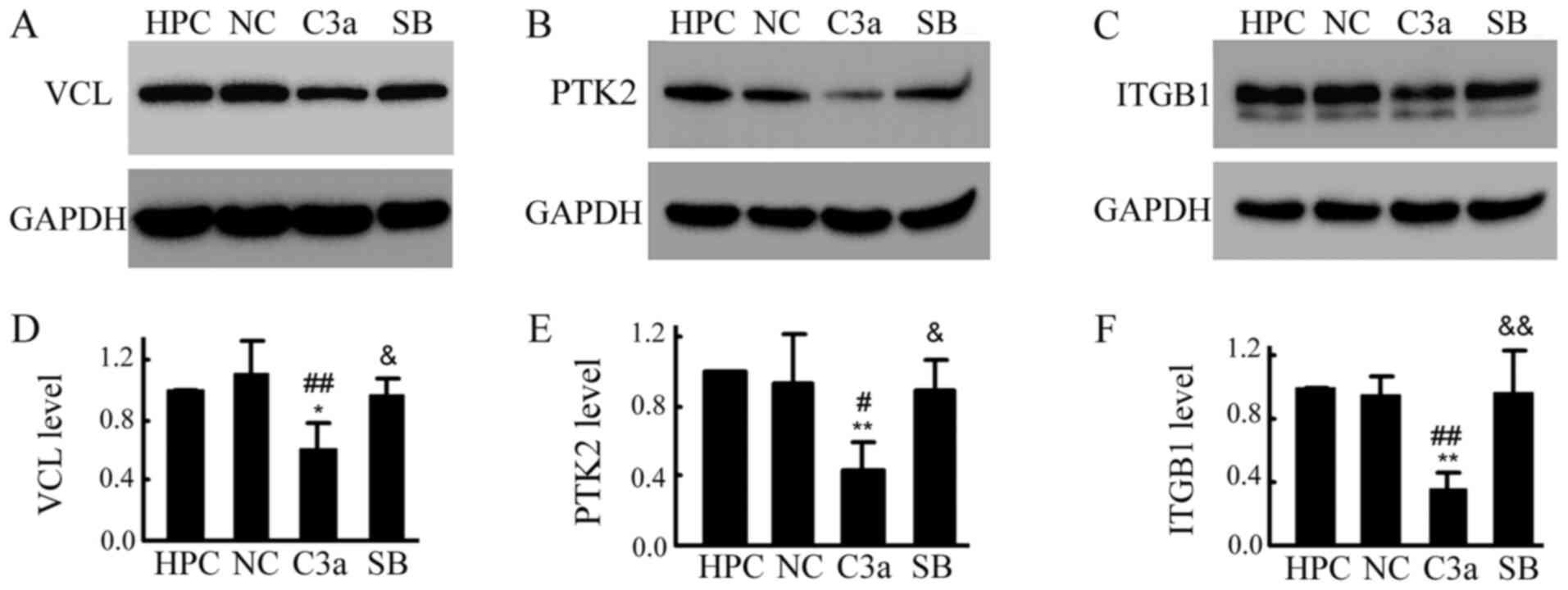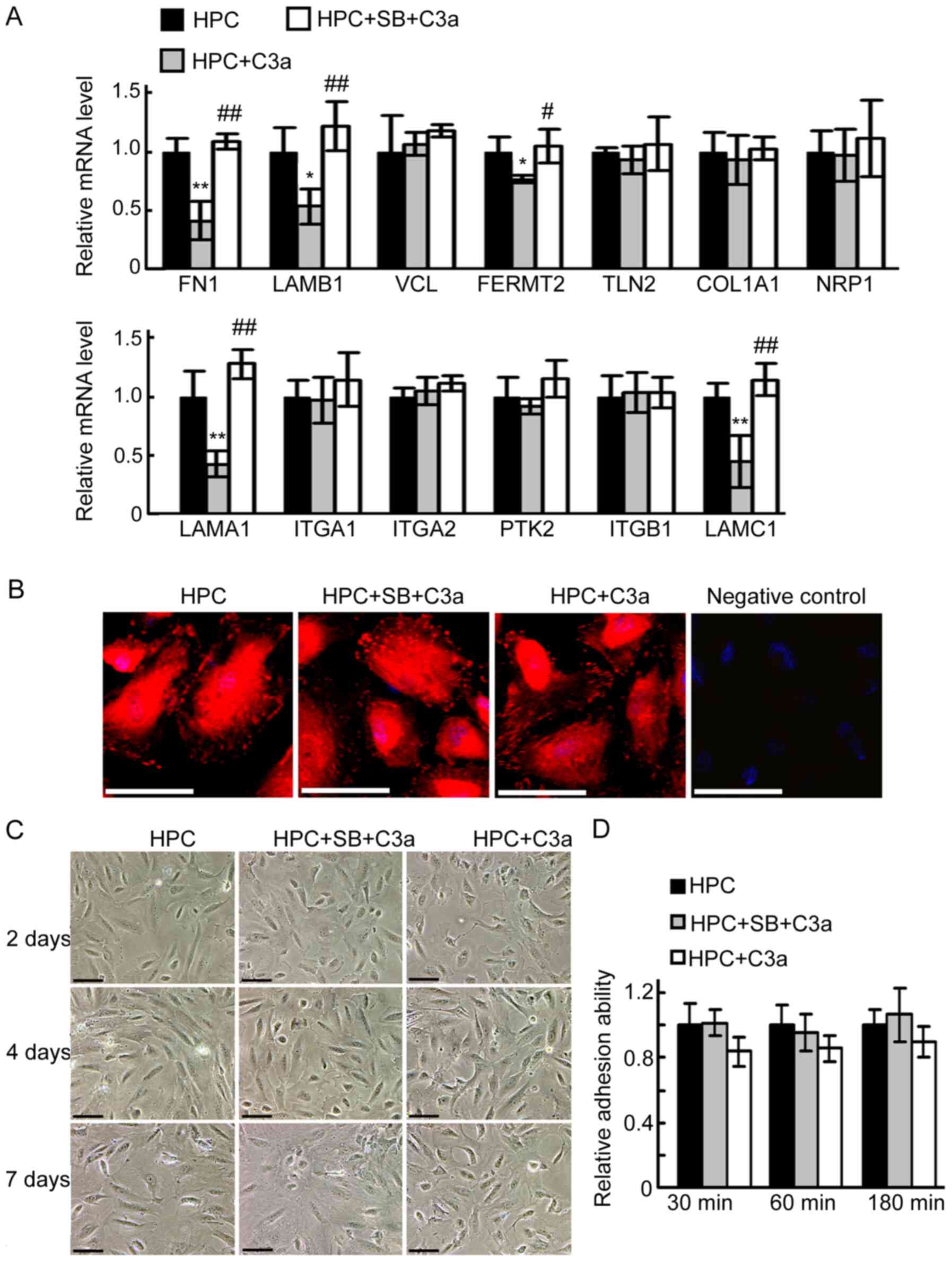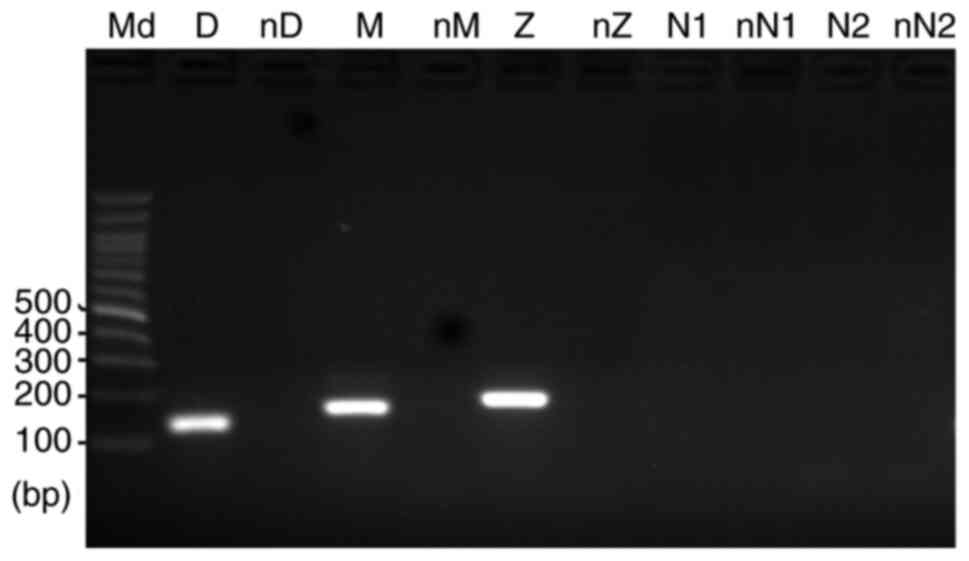|
1
|
Hawksworth OA, Coulthard LG, Mantovani S
and Woodruff TM: Complement in stem cells and development. Semin
Immunol. 37:74–84. 2018.PubMed/NCBI
|
|
2
|
Hawksworth OA, Coulthard LG and Woodruff
TM: Complement in the fundamental processes of the cell. Mol
Immunol. 84:17–25. 2017.PubMed/NCBI
|
|
3
|
Kwan WH, van der Touw W, Paz-Artal E, Li
MO and Heeger PS: Signaling through C5a receptor and C3a receptor
diminishes function of murine natural regulatory T cells. J Exp
Med. 210:257–268. 2013.PubMed/NCBI
|
|
4
|
Peng Q, Li K, Sacks SH and Zhou W: The
role of anaphylatoxins C3a and C5a in regulating innate and
adaptive immune responses. Inflamm Allergy Drug Targets. 8:236–246.
2009.PubMed/NCBI
|
|
5
|
Sacks SH: Complement fragments C3a and
C5a: The salt and pepper of the immune response. Eur J Immunol.
40:668–670. 2010.PubMed/NCBI
|
|
6
|
Lim J, Iyer A, Suen JY, Seow V, Reid RC,
Brown L and Fairlie DP: C5aR and C3aR antagonists each inhibit
diet-induced obesity, metabolic dysfunction, and adipocyte and
macrophage signaling. FASEB J. 27:822–831. 2013.PubMed/NCBI
|
|
7
|
Ohinata K and Yoshikawa M: Food intake
regulation by central complement system. Adv Exp Med Biol.
632:35–46. 2008.PubMed/NCBI
|
|
8
|
Bénard M, Raoult E, Vaudry D, Leprince J,
Falluel-Morel A, Gonzalez BJ, Galas L, Vaudry H and Fontaine M:
Role of complement anaphylatoxin receptors (C3aR, C5aR) in the
development of the rat cerebellum. Mol Immunol. 45:3767–3774.
2008.PubMed/NCBI
|
|
9
|
Broders-Bondon F, Paul-Gilloteaux P,
Gazquez E, Heysch J, Piel M, Mayor R, Lambris JD and Dufour S:
Control of the collective migration of enteric neural crest cells
by the Complement anaphylatoxin C3a and N-cadherin. Dev Biol.
414:85–99. 2016.PubMed/NCBI
|
|
10
|
Xu XH, Peng HS, Sun MQ, Hu M, Zhang R,
Wang WH, He XY and Xiao XR: C-terminal peptide of anaphylatoxin C3a
enhances hepatic function after steatotic liver transplantation: A
study in a rat model. Transplant Proc. 42:737–740. 2010.PubMed/NCBI
|
|
11
|
Davoust N, Jones J, Stahel PF, Ames RS and
Barnum SR: Receptor for the C3a anaphylatoxin is expressed by
neurons and glial cells. Glia. 26:201–211. 1999.PubMed/NCBI
|
|
12
|
Rahpeymai Y, Hietala MA, Wilhelmsson U,
Fotheringham A, Davies I, Nilsson AK, Zwirner J, Wetsel RA, Gerard
C, Pekny M, et al: Complement: A novel factor in basal and
ischemia-induced neurogenesis. EMBO J. 25:1364–1374.
2006.PubMed/NCBI
|
|
13
|
Shinjyo N, de Pablo Y, Pekny M and Pekna
M: Complement Peptide C3a Promotes Astrocyte Survival in Response
to Ischemic Stress. Mol Neurobiol. 53:3076–3087. 2016.PubMed/NCBI
|
|
14
|
Stokowska A, Atkins AL, Morán J, Pekny T,
Bulmer L, Pascoe MC, Barnum SR, Wetsel RA, Nilsson JA, Dragunow M,
et al: Complement peptide C3a stimulates neural plasticity after
experimental brain ischaemia. Brain. 140:353–369. 2017.PubMed/NCBI
|
|
15
|
Shinjyo N, Ståhlberg A, Dragunow M, Pekny
M and Pekna M: Complement-derived anaphylatoxin C3a regulates in
vitro differentiation and migration of neural progenitor cells.
Stem Cells. 27:2824–2832. 2009.PubMed/NCBI
|
|
16
|
Schlondorff J: How many Achilles' heels
does a podocyte have? An update on podocyte biology. Nephrol Dial
Transplant. 30:1091–1097. 2015.PubMed/NCBI
|
|
17
|
Nagata M: Podocyte injury and its
consequences. Kidney Int. 89:1221–1230. 2016.PubMed/NCBI
|
|
18
|
Reiser J and Sever S: Podocyte biology and
pathogenesis of kidney disease. Annu Rev Med. 64:357–366.
2013.PubMed/NCBI
|
|
19
|
Li X, Ding F, Zhang X, Li B and Ding J:
The Expression Profile of Complement Components in Podocytes. Int J
Mol Sci. 17:4712016.PubMed/NCBI
|
|
20
|
Locatelli M, Buelli S, Pezzotta A, Corna
D, Perico L, Tomasoni S, Rottoli D, Rizzo P, Conti D, Thurman JM,
et al: Shiga toxin promotes podocyte injury in experimental
hemolytic uremic syndrome via activation of the alternative pathway
of complement. J Am Soc Nephrol. 25:1786–1798. 2014.PubMed/NCBI
|
|
21
|
Saleem MA, O'Hare MJ, Reiser J, Coward RJ,
Inward CD, Farren T, Xing CY, Ni L, Mathieson PW and Mundel P: A
conditionally immortalized human podocyte cell line demonstrating
nephrin and podocin expression. J Am Soc Nephrol. 13:630–638.
2002.PubMed/NCBI
|
|
22
|
Boos L, Campbell IL, Ames R, Wetsel RA and
Barnum SR: Deletion of the complement anaphylatoxin C3a receptor
attenuates, whereas ectopic expression of C3a in the brain
exacerbates, experimental autoimmune encephalomyelitis. J Immunol.
173:4708–4714. 2004.PubMed/NCBI
|
|
23
|
Livak KJ and Schmittgen TD: Analysis of
relative gene expression data using real-time quantitative PCR and
the 2(−Δ Δ C(T)) Method. Methods. 25:402–408. 2001.PubMed/NCBI
|
|
24
|
Riveline D, Zamir E, Balaban NQ, Schwarz
US, Ishizaki T, Narumiya S, Kam Z, Geiger B and Bershadsky AD:
Focal contacts as mechanosensors: Externally applied local
mechanical force induces growth of focal contacts by an
mDia1-dependent and ROCK-independent mechanism. J Cell Biol.
153:1175–1186. 2001.PubMed/NCBI
|
|
25
|
Yadav P, Goyal VD, Gaur NK, Kumar A,
Gokhale SM, Jamdar SN and Makde RD: Carboxypeptidase in prolyl
oligopeptidase family: Unique enzyme activation and
substrate-screening mechanisms. J Biol Chem. 294:89–100.
2019.PubMed/NCBI
|
|
26
|
Matthews KW, Mueller-Ortiz SL and Wetsel
RA: Carboxypeptidase N: A pleiotropic regulator of inflammation.
Mol Immunol. 40:785–793. 2004.PubMed/NCBI
|
|
27
|
Reznik SE and Fricker LD:
Carboxypeptidases from A to Z: Implications in embryonic
development and Wnt binding. Cell Mol Life Sci. 58:1790–1804.
2001.PubMed/NCBI
|
|
28
|
Horton ER, Byron A, Askari JA, Ng DHJ,
Millon-Frémillon A, Robertson J, Koper EJ, Paul NR, Warwood S,
Knight D, et al: Definition of a consensus integrin adhesome and
its dynamics during adhesion complex assembly and disassembly. Nat
Cell Biol. 17:1577–1587. 2015.PubMed/NCBI
|
|
29
|
Zaidel-Bar R, Cohen M, Addadi L and Geiger
B: Hierarchical assembly of cell-matrix adhesion complexes. Biochem
Soc Trans. 32:416–420. 2004.PubMed/NCBI
|
|
30
|
Zamir E and Geiger B: Molecular complexity
and dynamics of cell-matrix adhesions. J Cell Sci. 114:3583–3590.
2001.PubMed/NCBI
|
|
31
|
Peng X, Maiers JL, Choudhury D, Craig SW
and DeMali KA: α-catenin uses a novel mechanism to activate
vinculin. J Biol Chem. 287:7728–7737. 2012.PubMed/NCBI
|
|
32
|
Grashoff C, Hoffman BD, Brenner MD, Zhou
R, Parsons M, Yang MT, McLean MA, Sligar SG, Chen CS, Ha T, et al:
Measuring mechanical tension across vinculin reveals regulation of
focal adhesion dynamics. Nature. 466:263–266. 2010.PubMed/NCBI
|
|
33
|
Hemmings L, Rees DJ, Ohanian V, Bolton SJ,
Gilmore AP, Patel B, Priddle H, Trevithick JE, Hynes RO and
Critchley DR: Talin contains three actin-binding sites each of
which is adjacent to a vinculin-binding site. J Cell Sci.
109:2715–2726. 1996.PubMed/NCBI
|
|
34
|
Goldmann WH: Role of vinculin in cellular
mechanotransduction. Cell Biol Int. 40:241–256. 2016.PubMed/NCBI
|
|
35
|
Izard T and Brown DT: Mechanisms and
functions of vinculin interactions with phospholipids at cell
adhesion sites. J Biol Chem. 291:2548–2555. 2016.PubMed/NCBI
|
|
36
|
Desban N, Lissitzky JC, Rousselle P and
Duband JL: alpha1beta1-integrin engagement to distinct laminin-1
domains orchestrates spreading, migration and survival of neural
crest cells through independent signaling pathways. J Cell Sci.
119:3206–3218. 2006.PubMed/NCBI
|
|
37
|
Mruthyunjaya S, Parveen D, Shah RD,
Manchanda R, Godbole R, Vasudevan M and Shastry P: Gene expression
analysis of laminin-1-induced neurite outgrowth in human
mesenchymal stem cells derived from bone marrow. J Biomed Mater Res
A. 103:746–761. 2015.PubMed/NCBI
|
|
38
|
Yamada M and Sekiguchi K: Molecular Basis
of Laminin-Integrin Interactions. Curr Top Membr. 76:197–229.
2015.PubMed/NCBI
|
|
39
|
Bachman H, Nicosia J, Dysart M and Barker
TH: Utilizing Fibronectin Integrin-Binding Specificity to Control
Cellular Responses. Adv Wound Care (New Rochelle). 4:501–511.
2015.PubMed/NCBI
|
|
40
|
Iwamoto DV and Calderwood DA: Regulation
of integrin-mediated adhesions. Curr Opin Cell Biol. 36:41–47.
2015.PubMed/NCBI
|
|
41
|
Li Z, Lee H and Zhu C: Molecular
mechanisms of mechanotransduction in integrin-mediated cell-matrix
adhesion. Exp Cell Res. 349:85–94. 2016.PubMed/NCBI
|
|
42
|
Sachs N and Sonnenberg A: Cell-matrix
adhesion of podocytes in physiology and disease. Nat Rev Nephrol.
9:200–210. 2013.PubMed/NCBI
|
|
43
|
Kanasaki K, Kanda Y, Palmsten K, Tanjore
H, Lee SB, Lebleu VS, Gattone VH Jr and Kalluri R: Integrin
beta1-mediated matrix assembly and signaling are critical for the
normal development and function of the kidney glomerulus. Dev Biol.
313:584–593. 2008.PubMed/NCBI
|
|
44
|
Dessapt C, Baradez MO, Hayward A, Dei Cas
A, Thomas SM, Viberti G and Gnudi L: Mechanical forces and TGFbeta1
reduce podocyte adhesion through alpha3beta1 integrin
downregulation. Nephrol Dial Transplant. 24:2645–2655.
2009.PubMed/NCBI
|
|
45
|
He P, Liu D, Zhang B, Zhou G, Su X, Wang
Y, Li D, Yang X, Hepatitis B and Virus X: Hepatitis B Virus X
Protein Reduces Podocyte Adhesion via Downregulation of α3β1
Integrin. Cell Physiol Biochem. 41:689–700. 2017.PubMed/NCBI
|
|
46
|
Borza CM, Su Y, Chen X, Yu L, Mont S,
Chetyrkin S, Voziyan P, Hudson BG, Billings PC, Jo H, et al:
Inhibition of integrin α2β1 ameliorates glomerular injury. J Am Soc
Nephrol. 23:1027–1038. 2012.PubMed/NCBI
|
|
47
|
Pozzi A, Jarad G, Moeckel GW, Coffa S,
Zhang X, Gewin L, Eremina V, Hudson BG, Borza DB, Harris RC, et al:
Beta1 integrin expression by podocytes is required to maintain
glomerular structural integrity. Dev Biol. 316:288–301.
2008.PubMed/NCBI
|
|
48
|
Chen C, Li R, Ross RS and Manso AM:
Integrins and integrin-related proteins in cardiac fibrosis. J Mol
Cell Cardiol. 93:162–174. 2016.PubMed/NCBI
|
|
49
|
Li SY, Mruk DD and Cheng CY: Focal
adhesion kinase is a regulator of F-actin dynamics: New insights
from studies in the testis. Spermatogenesis.
3:e253852013.PubMed/NCBI
|
|
50
|
Mierke CT: The role of focal adhesion
kinase in the regulation of cellular mechanical properties. Phys
Biol. 10:0650052013.PubMed/NCBI
|
|
51
|
Yasuda-Yamahara M, Rogg M, Frimmel J,
Trachte P, Helmstaedter M, Schroder P, Schiffer M, Schell C and
Huber TB: FERMT2 links cortical actin structures, plasma membrane
tension and focal adhesion function to stabilize podocyte
morphology. Matrix Biol. 68-69:263–279. 2018.PubMed/NCBI
|
|
52
|
Heeringa SF and Cohen CD: Kidney diseases
caused by complement dysregulation: Acquired, inherited, and still
more to come. Clin Dev Immunol. 2012:6951312012.PubMed/NCBI
|
|
53
|
Jalal D, Renner B, Laskowski J, Stites E,
Cooper J, Valente K, You Z, Perrenoud L, Le Quintrec M, Muhamed I,
et al: Endothelial microparticles and systemic complement
activation in patients with chronic kidney disease. J Am Heart
Assoc. 7:e0078182018.PubMed/NCBI
|
|
54
|
Lesher AM and Song WC: Review: Complement
and its regulatory proteins in kidney diseases. Nephrology
(Carlton). 15:663–675. 2010.PubMed/NCBI
|
|
55
|
Mizuno M, Suzuki Y and Ito Y: Complement
regulation and kidney diseases: Recent knowledge of the
double-edged roles of complement activation in nephrology. Clin Exp
Nephrol. 22:3–14. 2018.PubMed/NCBI
|
|
56
|
Salant DJ: Introduction:
Complement-mediated kidney diseases. Semin Nephrol. 33:477–478.
2013.PubMed/NCBI
|
|
57
|
Eng DG, Sunseri MW, Kaverina NV, Roeder
SS, Pippin JW and Shankland SJ: Glomerular parietal epithelial
cells contribute to adult podocyte regeneration in experimental
focal segmental glomerulosclerosis. Kidney Int. 88:999–1012.
2015.PubMed/NCBI
|
|
58
|
Shankland SJ, Freedman BS and Pippin JW:
Can podocytes be regenerated in adults? Curr Opin Nephrol
Hypertens. 26:154–164. 2017.PubMed/NCBI
|
|
59
|
Bao L, Osawe I, Haas M and Quigg RJ:
Signaling through up-regulated C3a receptor is key to the
development of experimental lupus nephritis. J Immunol.
175:1947–1955. 2005.PubMed/NCBI
|
|
60
|
Braun MC, Reins RY, Li TB, Hollmann TJ,
Dutta R, Rick WA, Teng BB and Ke B: Renal expression of the C3a
receptor and functional responses of primary human proximal tubular
epithelial cells. J Immunol. 173:4190–4196. 2004.PubMed/NCBI
|
|
61
|
Horton ER, Byron A, Askari JA, Ng DHJ,
Millon-Frémillon A, Robertson J, Koper EJ, Paul NR, Warwood S,
Knight D, et al: Definition of a consensus integrin adhesome and
its dynamics during adhesion complex assembly and disassembly. Nat
Cell Biol. 17:1577–1587. 2015.PubMed/NCBI
|















